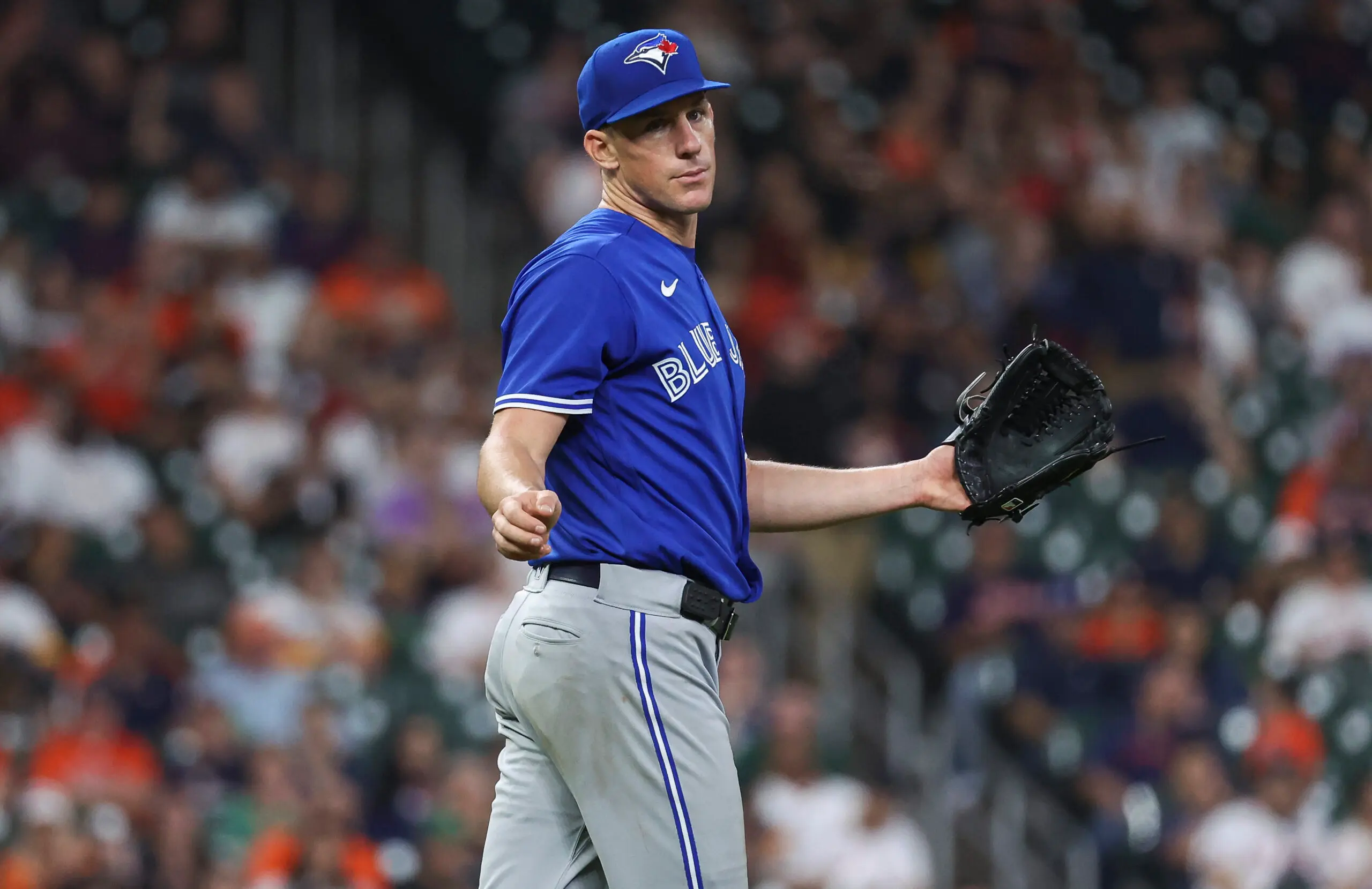A complete game shutout for Chris Bassitt! 👏 Bassitt retired 13 in a row to start the game, and retired the final 11 batters in a row to end the game. Bassitt's final line: 9 IP, 0 R, 2 H, 2 BB, 8 Ks
Chris Bassitt and the First Inning Blues: An Inning by Inning Breakdown

Photo credit: Troy Taormina-USA TODAY Sports
Jun 27, 2023, 09:00 EDTUpdated: Jun 27, 2023, 08:56 EDT
This past offseason, the Blue Jays made a splash in free agency and brought in veteran Chris Bassitt on a three-year deal, sacrificing a second-round pick in the upcoming MLB Draft to sign the versatile right-hander after he rejected the New York Mets qualifying offer.
Originally drafted by the Chicago White Sox back in 2011, Bassitt really came into his own after he was traded to the Oakland A’s alongside former Jays infielder Marcus Semien back in 2014. The right-hander amassed a 3.44 ERA through 100 outings in California while also coming back from Tommy John surgery in the mid-2010s before eventually finding himself traded to the Mets prior to the 2022 season, where he would spend just one season in New York.
By acquiring Bassitt, the Jays were adding a veteran arm that gave the Blue Jays one of the deepest rotations in the American League on paper heading into the campaign, boasting Alek Manoah, Kevin Gausman, José Berríos, and Yusei Kikuchi, who earned the fifth spot out of Spring Training.
Fast forward to the halfway mark in the season and Bassitt has seen his fair share of ups and downs.
He became the first Blue Jays pitcher since Mark Buerhle in 2015 to throw a complete-game shutout when he tossed a solid nine innings against the Atlanta Braves back in mid-May but also had one of the roughest debuts in Jays history, allowing four home runs to the tune of nine earned against the Cardinals back on April 2nd, lasting just 3 1/3. So far, Bassitt has amassed a 4.32 ERA through 16 starts and 93 2/3 innings with the Jays, going six or more innings in 10 starts this year already. The right-hander also owns a 5.04 FIP with a 1.206 WHIP while striking out batters at a 7.8 K/9, utilizing eight different pitches to try and generate weak contact.
Chris Bassitt’s Inning by Inning Breakdown
Bassitt is finding some similarities to what Berríos experienced last season, where he has quality starts with limited runs allowed but really struggling in games where he is off, with the right-hander allowing seven or more earned runs through three separate outings. Every other start has seen the University of Akron alum produce at max four runs, which is a vast difference from the outings where he struggles to keep the ball out of the middle of the plate. Bassitt even had a stretch of 28 2/3 innings in early May where he didn’t allow a single run against some tough competition, finding ways to keep hits limited and batters off the basepaths.
Interestingly enough, when you look a little deeper into the split stats, the first inning has been the biggest hurdle for the Ohio product. Bassitt owns a 9.00 ERA in the first inning alone, allowing 16 runs off of 18 hits while opposing hitters are authoring a 1.019 OPS with six home runs, the most he has allowed compared to all other innings pitched.
Coming up next is the third inning, where Bassitt sees his ERA lower to 6.75 but still with 15 runs allowed, presumably facing either the bottom part of the opponent’s batting order or potentially the top of the lineup again for the second time, depending on how the previous two innings fared. Those who bat second in the lineup have done the most damage (.386 average and 1.189 OPS) but those batting sixth in the lineup have also found barrel to the ball against Bassitt, with four home runs coming via that spot in the order to the tune of a 1.136 OPS (which kind of contradicts the inning breakdown unless the sixth batter comes up in the first inning, which has happened a few times this season for Bassitt).
| Split | IP | ER | ERA | AB | R | H | 2B | 3B | HR | BB | SO | BA | OBP | SLG | OPS | BAbip |
|---|---|---|---|---|---|---|---|---|---|---|---|---|---|---|---|---|
| 1st inning | 16.0 | 16 | 9.00 | 63 | 16 | 18 | 4 | 0 | 6 | 8 | 19 | .286 | .384 | .635 | 1.019 | .316 |
| 2nd inning | 16.0 | 3 | 1.69 | 59 | 6 | 12 | 5 | 0 | 2 | 5 | 16 | .203 | .266 | .390 | .655 | .244 |
| 3rd inning | 16.0 | 12 | 6.75 | 70 | 15 | 21 | 4 | 0 | 3 | 6 | 16 | .300 | .351 | .486 | .836 | .346 |
| 4th inning | 14.0 | 7 | 4.50 | 48 | 7 | 11 | 1 | 0 | 1 | 8 | 8 | .229 | .333 | .313 | .646 | .250 |
| 5th inning | 12.0 | 5 | 3.75 | 44 | 5 | 11 | 2 | 1 | 2 | 2 | 10 | .250 | .320 | .477 | .797 | .273 |
| 6th inning | 10.0 | 1 | 0.90 | 33 | 1 | 4 | 2 | 0 | 1 | 2 | 8 | .121 | .237 | .273 | .510 | .125 |
| 7th inning | 6.0 | 1 | 1.50 | 24 | 1 | 4 | 0 | 0 | 1 | 1 | 2 | .167 | .200 | .292 | .492 | .143 |
| 8th inning | 2.2 | 0 | 0.00 | 8 | 0 | 0 | 0 | 0 | 0 | 0 | 0 | .000 | .000 | .000 | .000 | .000 |
| 9th inning | 1.0 | 0 | 0.00 | 3 | 0 | 0 | 0 | 0 | 0 | 0 | 2 | .000 | .000 | .000 | .000 | .000 |
Provided by Baseball-Reference.com: View Original Table
For example, in his worst outing of the year (debut against the Cardinals), he gave up three home runs in the first inning, settled down in the second against the eight, nine, and leadoff hitters, and then struggled against the heart of the order and allowed three more runs. He did allow another run in the fourth and reliever Zach Pop gave up a double that scored another run charged to Bassitt but the main damage was done in those two innings against the top to the middle of the lineup, stretching down to the sixth batter.
Blue Jays’ Bassitt and his Ability to Pitch Deep Into Games
As the game continues on, Bassitt seems to lock in and get better, which is a bit skewed considering the sample size in relation to the later innings, as he has only made it to the seventh inning on seven occasions compared to the first to third innings, a threshold he has moved past in each of his 16 starts. The fourth and fifth inning has given him a bit of trouble, with the fourth being one of his wilder innings in terms of the free passes, but it seems that when Bassitt is truly locked in and throwing well and able to get out of the third inning with little damage, he just continues to improve as the game goes on, reaching the eighth inning on three separate occasions.
To throw even more of a wrinkle into his inning-by-inning rundown, the second inning has also produced great results similar to his deeper outing/inning stats, with six runs allowed through 12 hits while facing 59 batters. It is one of the more peculiar breakdowns you can see from a starting pitcher but to be fair, Bassitt isn’t your typical pitcher, with the right-hander calling most of his games via the PitchCom device on his belt coming into his last start, where he gave up control to Danny Jansen for the first time all season.
Looking ahead, Bassitt has shown that he has the ability to pitch deep into the ball games when all things are firing correctly, producing weak contact and making hitters think of the eight different pitchers he could throw at you at any given time in the game. The left-handers have also given him trouble in the batter’s box compared to the righties (.972 OPS vs. .510 OPS) and the righty-pitcher also boasts better stats at the Rogers Centre as well, limiting hitters to just a .148 average while opponents own a .298 average with 13 of 16 home runs coming on the road (as well as his three outings where he has allowed seven or more earned runs). As I mentioned earlier, the consistency at times hasn’t been there, whether it be the innings impact, the split stats against lefties vs. righties, or even the month (May was his only sub-3.00 ERA where both April and June are above the 5.00 mark), with some harsh outings really impacting the overall stats on the year.
If he can find a way to limit the damage and reduce the outliers where he gives up seven or more earned, as well as find a way to start ballgames on a better note, he along with the rotation of Gausman, Berríos, Kikuchi, and hopefully a revamped Manoah in the near future will give the Blue Jays a strong chance to make another run for the postseason here in 2023.
ARTICLE PRESENTED BY BETANO

Breaking News
- On this day a year ago: The Blue Jays acquire Andrés Giménez
- Blue Jays sign swingman Michael Plassmeyer to minor-league deal
- Blue Jays lose zero players to the Rule 5 Draft
- Blue Jays select Hedbert Perez in minor league portion of Rule 5 draft
- Report: Pete Alonso agrees to five-year, $155 million contract with the Baltimore Orioles

